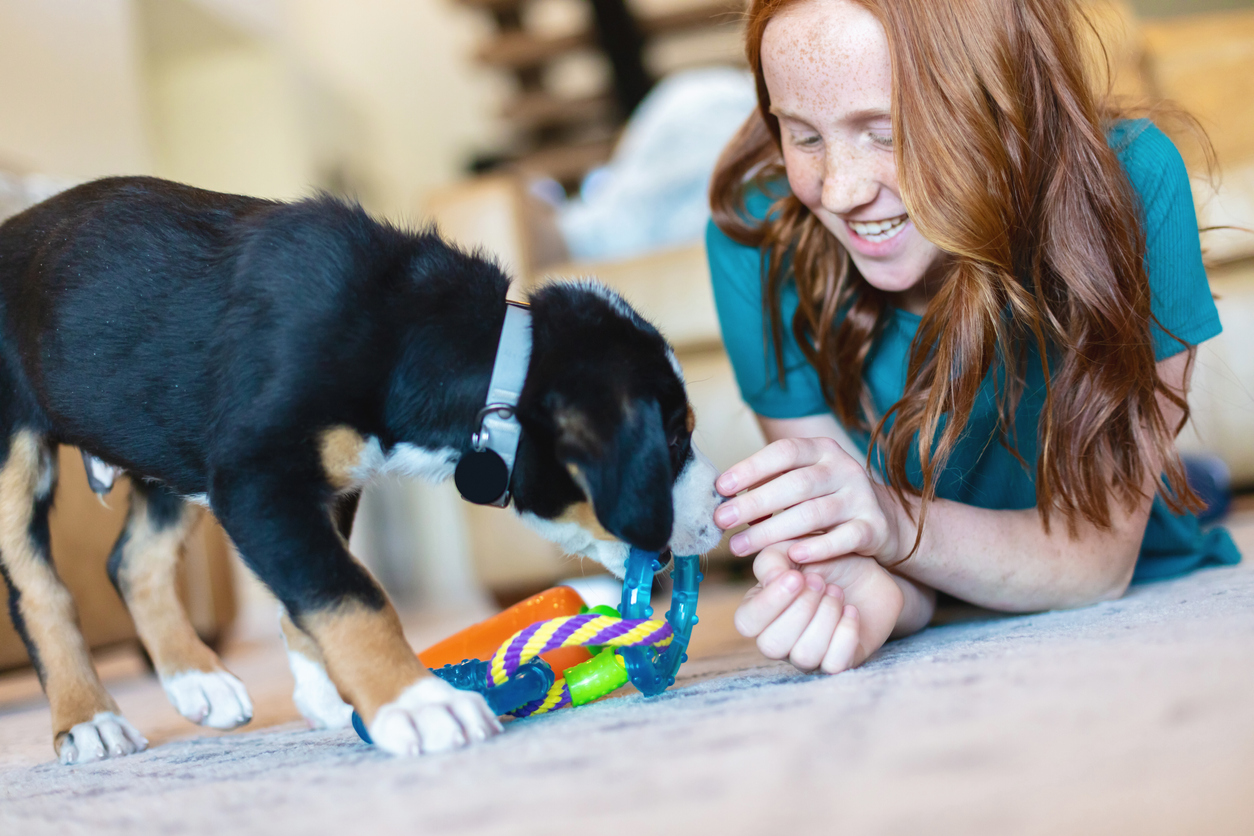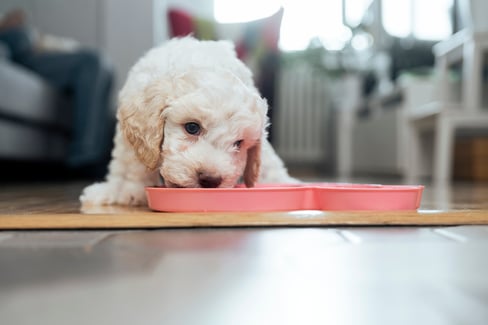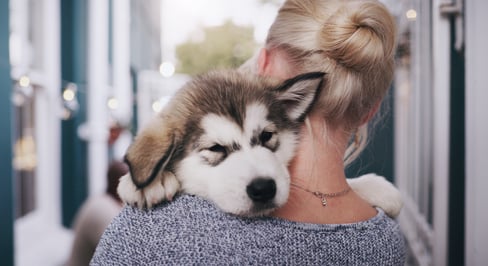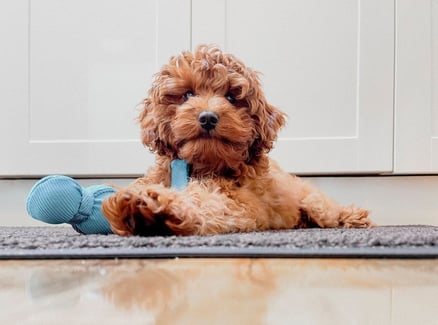Table of Contents
Ah, puppy love. Nothing is as cute as a small dog running around the house with its nose to the ground and tail wagging.
But puppies also come with their own set of challenges. There’s so much to learn about them, it can seem overwhelming! And like a good pet pawrent you will also want to make sure you are doing everything correctly, from feeding to teething to training so they can grow up healthy and happy.
One thing that can make that transition from puppy to adult dog easier is by implementing some simple new puppy tips and tricks for the first few weeks and months to make adding your sweet pup to the family a breeze.
OK – let’s get into the new puppy tips you need to know so you can take a breather before bringing your puppy home.
Puppy Tips for the First Week
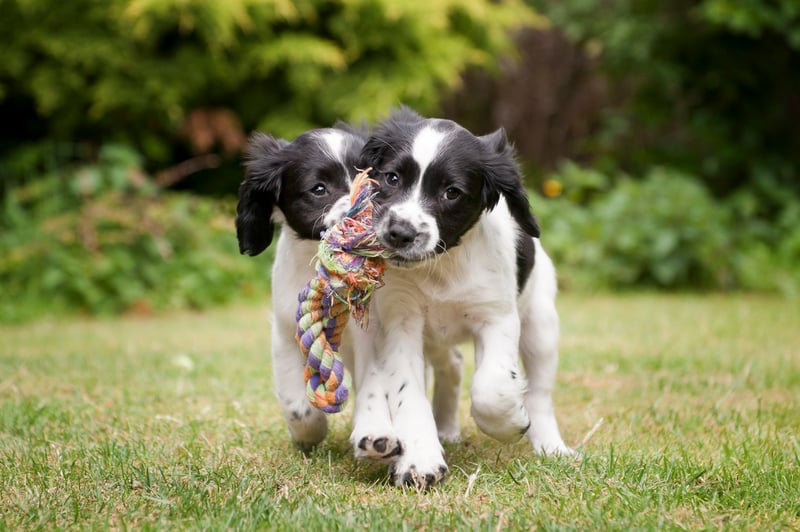
Nothing is more exciting (and important!) than the first week with your puppy. Even before you bring them home it is an exciting time for your whole family!
But there is plenty to do before you bring a puppy home for the first time. You should be prepared by researching, making a plan for your puppy, and educating family members about their new puppy's responsibilities.
It's important not to miss any of these new puppy tips because it could mean problems for you and your puppy later on, so without further ado, let’s get into it!
Tip #1: Be Prepared
Of course, bringing a puppy home is all about puppy prep!
So what exactly do you need to ‘add to cart’ before picking up your sweet puppy? Remember that while all those fun toys and treats may seem like the best thing to stock up on, there are other key things that should be purchased, too.
First-time puppy owner tips for shopping lists should include the following items:
- Dog crate
- Dog bed
- Leash and collar
- Puppy food
- Puppy supplements
- Registration and tags for pets
- Water and food bowls
- Puppy chew toy (appropriately sized)
- Soft toys (appropriate for puppies)
- Tools for grooming
- Safety gate or puppy pen
- Bags for waste pick-up
- Stain removal supplies for puppies
It’s not just your shopping list to prepare for your new puppy. Be prepared to make schedules and plans and find a vet beforehand, too.
Your home should also be prepared for the chaos and excitement of a new puppy. One of the most important new puppy tips is to ensure your home is safe for these curious little furballs in case they decide to get too curious and get themselves into trouble.
Puppy proofing tips for your home can include the following:
- Ensure your home is safe before bringing your puppy home.
- Dangerous items for your puppy, like electrical cords and cleaning supplies, should be covered or locked away to protect your pup from chewing them.
- For items that aren't dangerous to your pup but you don't want to be chewed up by puppies (like shoes), be sure to tuck them away.
- The first thing you should do if your puppy gets into something they shouldn't is to redirect them to a chew toy alternative.
Tip #2: Keep Calm
Puppies need a calm environment. After all, this can be a very stressful experience with new sights, sounds, and smells to take in! Be mindful of how much stimulation you're providing your puppy with, especially if you have kids or other pets in the home.
That is why it can be helpful to set expectations with kids and family members beforehand. Puppies are still learning how much is too much when it comes to socialization with humans, so it's best not to overwhelm them.
You should also make sure everyone in your household spends time socializing with your puppy to avoid developing anxious habits and tendencies. For children especially, it can be important to help them understand how to treat their new puppy, and how to safely play with them.
Here are some new puppy tips for working with your children on handling their new addition:
- Before getting the puppy, teach your children how to hold and play with it.
- Show the children how to hold, pet, and play with a puppy using a stuffed toy, and make sure everyone understands the ground rules!
- It's vital that they understand that rough-housing, poking, and ear-pulling are not allowed, and they need to be gentle when hugging and holding the puppy.
- Young children should always sit on the floor when holding the puppy to ensure they won't hurt the little furball by dropping them.
Tip #3: Get Into a Routine Right Away
It's important to start your new puppy off with a routine, so they can get used to the things that happen daily. If you're consistent, this will make them more comfortable in their new home.
Why?
They need consistency to feel comfortable and settled – but they also benefit from having fun during routine activities like feeding time! This encourages bonding through playtime, which helps create positive associations with feeding time, making it less stressful for both parties involved!
Remember: repetition works best here – don't try anything new until you've established what works best first! This is true of both daytime and nighttime routines, which are different but equally important.
The first thing you should do is to plan your routine for feeding, bathroom trips, exercise, and grooming.
The table below outlines some key new puppy tips for building a positive routine.
|
Feeding |
If possible, keep the same routine your breeder followed before collection until your puppy settles in.To establish a feeding routine, you should feed your puppy at the same time and place every day. |
|
Bathroom Trips |
A schedule that is followed daily can help you and your puppy understand their potty needs better. If your puppy has an accident in the house, do not punish them. It simply doesn't have the outcome you think it will. In fact, most of the time, yelling and aggression will only cause your pup to have more accidents in the house! In this case, you should simply interrupt your puppy with a simple “Uh-oh! Outside!” cue and lead them outside to go potty. Provide them with rewards if they resume their "business" in the right location. |
|
Nighttime Routine |
Teach your new puppy where they sleep and what it looks like when it is time to go to sleep. This may include a bathroom break, a treat, brushing or grooming, and then leading them to their crate or bed. |
Tip #4: Visit the Vet
By visiting the vet early on in your puppy’s life, you can be sure that the transition will be a smooth one for both you and your dog. Not only does it get them used to going in for check-ups, but it also helps them avoid health problems down the road.
A new puppy tip for visiting the vet includes a check on their overall health including:
- Vaccinations
- Parasite check
- Microchipping
- Spay or neutering consultation and planning
- Dental checkup
- Blood tests
- Heartworm check and prevention
- Flea and tick prevention
Your vet can also make recommendations regarding feeding and the best food for your pup, as well as offer custom recommendations for your specific puppy’s breed and needs. For example, if they are a breed that has a history of elbow or hip dysplasia, they can screen for the condition and make plans to help your pup get more comfortable.
In this case, they may suggest a joint health supplement like TRI-ACTA for pets that can help your puppy grow strong, and help them develop their joints and bones correctly. TRI-ACTA for pets is safe to feed to puppies, and can offer them the ability to build a solid foundation for a healthy adult life. And when they become more senior than puppy, you can switch them to TRI-ACTA H.A. for pets, which can help make them more mobile in their golden years.
TRI-ACTA for Pets
A proactive approach for developing and younger adult pets to maintain optimal joint health mobility, minimize inflammation and fend off age-related ailments.
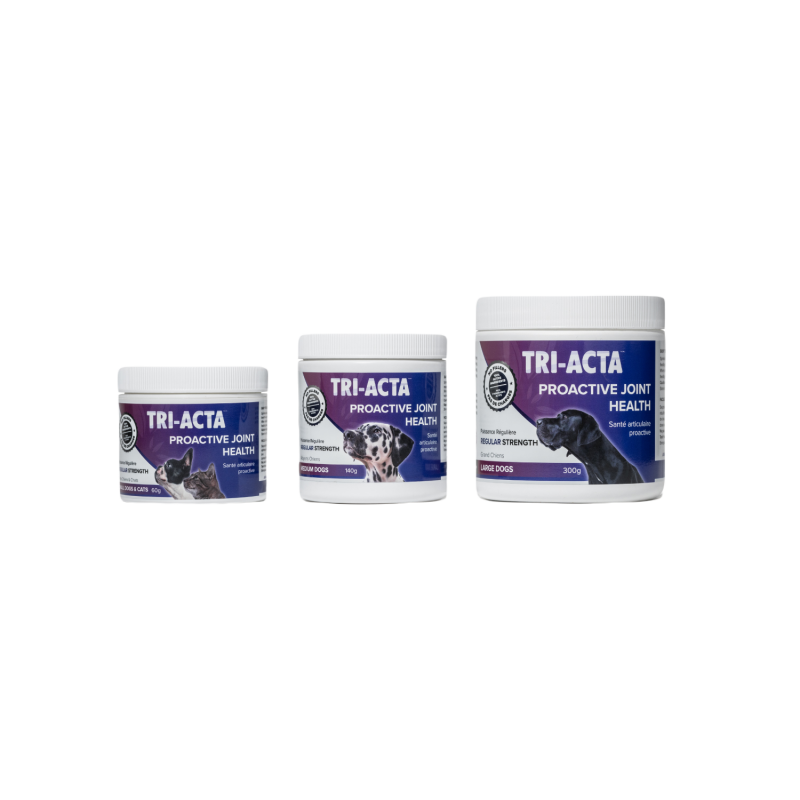
Tip #5: Begin Training
Did you know that puppies are more willing to accept new experiences from 4 to 16 weeks of age because their brains are developing? That’s why it’s so important to get them started with basic training and to introduce them to new experiences during this time.
There are many different methods of training that you can use for your puppy. Some people like to start with obedience classes, which are a great way to get your puppy used to being around other dogs and learning how to behave in public. Sign up for puppy classes as soon as your vet says it's safe to do so (which is after their first vaccines).
In the meantime, try “play training” at home! That looks like training your puppy several times a day, at short intervals, and making it fun for their short attention spans. You can begin by teaching your puppy how to recognize their name, then move on to more complex commands such as sit, stay, and come here (more on that later).
In addition, you'll want to begin crate training at this time in order to assist your pup when they need to stay home on their own.
The table below outlines some key training areas and some puppy tips for getting started.
|
Training Area |
Puppy Tips |
|
|
|
|
|
Tips for Training a Puppy
The old saying goes, you can’t teach an old dog new tricks, so when do you teach them how to sit, stay, roll over, and come to you? The answer is definitely during puppyhood. This is when they are the most open to learning, and their brains are the most flexible, just like humans are when they are young!
But puppies also have poorer logical reasoning skills than their adult counterparts, so they need to be taught how to train in a way that makes sense for puppies.
We’re going to share some tips for training a puppy here so you can get your puppy learning ASAP!
Tip #1: Get Things Off to a Good Start
You should create an environment in which your puppy feels safe before you begin to train them.
When it comes to tips for training a puppy, there are two key factors to consider first:
- Developing relationships between your puppy and family
- Creating a structure for your new family member
In fact, once you establish a caring and trusting bond with your dog, teaching them specific commands and behaviors will be a lot easier (and more enjoyable!).
Tip #2: Keep it Short and Sweet
Once you have your puppy bonding down, you can begin short, concise training sessions. After all, there is no such thing as a long attention span for puppies! This is called training fatigue. Think back to how you felt going to school for the first time – tired and likely, fidgety by the first morning snack! Your new puppy feels the same way. That's why it's important to break training into puppy-sized chunks.
Here are some tips for new puppy owners to keep in mind during your next session:
- Train frequently and for short periods of time. And don't be surprised if the same session needs to be repeated several times.
- Focus on 5-10 minutes at a time and build up from there, including a variety of activities and tasks.
- Look for signals that your dog is done with training for now. This can include watching for them to increase vocalization, searching the room for an exit, or even wandering off.
Tip #3: Reward Often
In the training process, you should let your puppy know when they have done something right. This is important to keep your puppy motivated, and it's also a great way to bond with them! Rewards can be treats, praise, or even a favorite toy. Dogs are natural hunters and love anything that makes them work for their food – so you'll definitely want to use treats as rewards during training sessions!
Just remember that it is important to use low-calorie, healthy puppy treats or kibble from their daily food when you reward them. As a result, all of these will encourage good behaviour to continue.
Our puppy tips and tricks include choosing good treats for your new addition like:
- Soft training treat bites
- Freeze-dried bits of liver or other meat
- Puppy biscuits
- Dog-friendly fruits and vegetables in bite-sized pieces
Tip #4: Engage the Pros
Getting your dog on the right path is easy and affordable with a puppy class. There are many benefits to puppy training classes, including socialization and learning to work with humans. As a puppy owner, you'll learn how to keep your dog attentive in a distraction-filled environment and introduce them to other puppies and people.
But be aware that not every puppy class is created equal.
You should learn puppy training tips and tricks from a class that:
- Has good reviews and is reputable in the community
- Offers previews and tours of their classes
- Provides all information about pricing upfront
- Doesn’t pack the class too full (6 - 8 other puppies)
- Covers all the basics
- Has the right dog training philosophy for your needs and breed
- Is taught by an experienced provider
You could also go with a private dog trainer for some one-on-one training for both you and your new puppy. They can be more costly, but they can also be more effective than a larger class. There are many types of trainers out there who specialize in different breeds and training methods, and it’s important that you find one that matches your goals for your new puppy.
Puppy Tricks
Puppies typically receive training after the age of 12 weeks due to vaccination schedules, but plenty of people agree that earlier is best. You can really begin training puppies as early as 8 weeks old, just keep it in your home and tailor it to their needs.
That’s because they are exceptionally curious and already learning plenty about the world around them at this age – perfect for learning new things! Just remember that you need to keep the sessions short, sweet, and full of rewards.
Trick #1: Sit
Your new furry friend will learn to sit quickly. It's an easy trick that benefits your dog when they are still young and impressionable since you can use it for training purposes later on.
How To:
- Bend down and hold a treat in front of your pup.
- Put the treat in front of the dog's nose and let them smell it.
- Gradually raise the treat above their head.
- In order to get the treat, the puppy lifts their head, lowering their bottom to the ground.
- Continue by repeating these steps.
- You can begin training without the treat once your puppy has associated the food with the hand signal.
- This time, say "sit." Their understanding of this word will grow as you train them.
- Reward them with a treat and encouragement when he sits.
Trick #2: Stay
Stay is a great command to teach your puppy, as it can save you from having your adorable friend doing some accidental damage! This trick is also useful for when you want your puppy to stay right next to you while he's playing with another dog or human.
How To:
- Stand beside your puppy while they stand or sit.
- Immediately after throwing a treat on the floor, say your release word. This word could be any word you choose but "go" or "OK" are common cues.
- Do it again a couple of times.
- Throw the treat down after saying the release word. It becomes a cue that gets your puppy moving.
Trick #3: Lay Down
This trick is similar to the previous one, but with a bit more advanced movements. Lay Down requires your puppy to lay down all the way and stay that way until you give them permission to get up.
How To:
- Slowly lower a treat in your hand to the ground. Give the puppy the treat when he lowers his head to get it
- You should repeat this process until you can do it without holding a treat
- Don't forget to give him a treat after he lays down when you don't have the treat in your hand initially
- After you set the hand signal for him to follow, start saying "down" when the behavior is performed
Puppy Teething Tips
Puppies are often 2 to 6 months old when they do most of their growth, including their teeth! By 3 to 6 months old, puppies begin to lose their teeth. So don’t be alarmed if you find a tooth lying around! It’s natural and a sign your pup is growing healthy and strong.
Signs of a puppy teething include:
- Small blood stains on chewed items
- Difficulty eating their food or being picky
- The act of chewing to relieve pain
- Drooling
- Bad breath
- Whimpering or crying
Now that you know what the signs of puppy teething are, it’s time to learn how to cope with this challenging stage.
Tip #1: Soothe Sore Gums and Teeth
When your little puppy is teething, you need the right tools to keep them soothed and calm.
If you have ever helped a baby through their teething stage, you know it can come down to soothing their sore gums with various solutions. Puppies are not much different than that. They require a little extra attention to keep them from becoming upset and the right tools.
Some common solutions pet parents offer for puppy teething tips include the following tools:
- Ice cubes
- Frozen beef or chicken broth cubes
- Dog-safe frozen fruits or vegetables
- Frozen washcloth
All of these can offer a safe alternative to chewing on shoes and household items while cooling and soothing sore, irritated gums.
Tip #2: Adjust Feeding Accordingly
When puppies are teething, they can be reluctant to eat – who wouldn’t be! It hurts, and their little mouths are sore and irritated. When your puppy seems reluctant to eat their dry food due to teething, don't switch to a new formula. Changes in their diet can cause extra stress and upset their tummy – adding to the drama of puppy teething.
These new puppy tips for teething can help you through this tough process:
- Add canned puppy food to your puppy's regular dry food to soften it and make mealtime more enjoyable.
- To soften dry food, add a small amount of warm water. When your puppy is done eating, make sure to take away any leftover food, as moist food can breed bacteria.
- The teeth can become looser after eating dry food and biscuits, so pups can get through teething faster.
- Seek the advice of your veterinarian if your puppy's appetite loss persists or before switching foods.
Tip #3: Chew with Care
To avoid a mess of chewed shoes and furniture, provide your puppy with several types and textures of chew toys, and ensure that they are suited to the size of your puppy. Firm rubber toys with textured bumps or ridges are the best kinds of toys for chewy little puppies.
You should always supervise your puppy while they are chewing and regularly inspect the toys to ensure chunks have not been taken out. Toys that are damaged should be thrown away. Doing this can avoid the hazards of choking.
Additionally, while you may want to give them a tasty treat, offering your puppy rawhide as a chew toy can result in intestinal blockages. And while offering them sticks on your walk can seem like a fun idea, it can often result in mouth injuries and create another choking hazard.
Golden Retriever Puppy Tips
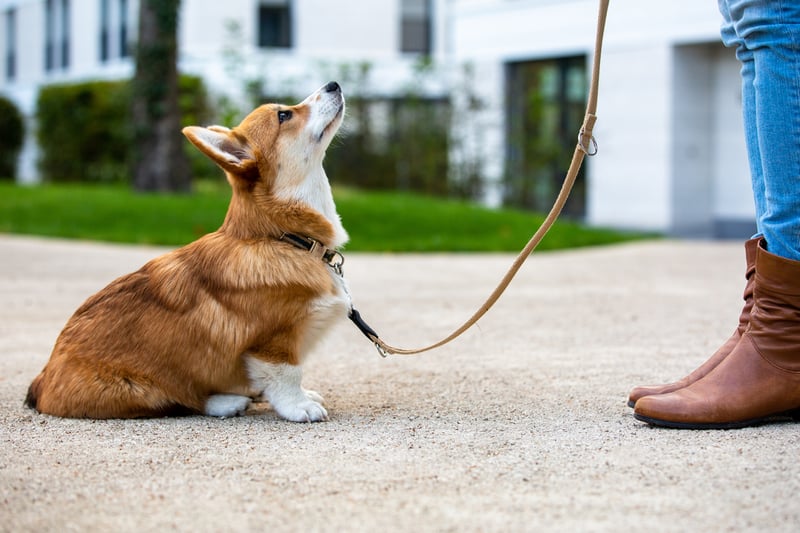
Beginning as a working breed in the mid-1800s, Golden Retrievers are known for their bouncy personality, making for excellent family pets and continue to be hard little workers, working today as everything from service dogs to search and rescue dogs.
They, like all dogs, need specialized attention to ensure their success in going from puppyhood to adulthood, so let’s talk about some Golden Retriever puppy tips.
Tip #1: Find a Reputable Breeder
Goldens are a purebred that can be pricey and in-demand, leading to dangerous, disreputable breeders preying on those searching for their perfect pup to add to the family.
Either adopt from a rescue organization or find a registered breeder who is recommended by groups like the AKC and CKC. This avoids the scary realities of puppy mills, and can also avoid bad health outcomes later on, too.
Tip #2: Exercise Easy
It is well known that golden retrievers are extremely energetic dogs, especially when they are puppies! However, due to their puppy-sized bodies, they do need less exercise than adult dogs do.
There's a simple formula to determine how much time to spend walking your dog. Ideally, you want to add 5 minutes of gentle walking time per month of age. So if your puppy is 5 months old, you will want your walks to be about 10 minutes at a time, twice to three times per day.
Overdoing it can be more harmful than beneficial. The first few months of a puppy's life are a crucial time for them to grow, so too much exercise can lead to exhaustion and joint damage.
A golden retriever with hip dysplasia is common, and too much exercise at a young age can aggravate the condition. In addition to Great Danes and Saint Bernard dogs, Golden Retrievers are among other large breeds primarily affected by hip dysplasia because of their size and breed characteristics. Signs can also appear as early as a few months or as late as a few years.
Feeding a supplement can help combat conditions like hip dysplasia from causing your pup pain and discomfort. Integricare TRI-ACTA for pets is a perfect choice for helping cartilage stay strong and for the support of healthy growth and development. And when they get older, if they do develop golden retriever hip dysplasia, you can feed them Integricare’s TRI-ACTA H.A. for pets, which includes the addition of hyaluronic acid to help increase joint fluid viscosity and improve mobility for your pup.
TRI-ACTA H.A. for Pets
Our maximum strength formula is optimally designed to accelerate the formation of cartilage, minimize inflammation, expedite the healing process, and improve joint conditions.

Pitbull Puppy Training Tips
Sadly, Pitbulls are branded with a bad reputation that is undeserved. There is no doubt that they are some of the sweetest and most loving dogs you will ever meet in your life. As with any dog, they are also products of their environment.
Because of this, it's so important to train your Pitbull puppy correctly, as training them is crucial to success later on in life.
Tip #1: Adapt Training to Breed Needs
Pitbulls as a breed are strong, powerful, and need something other than leash correction and physical correction. Much of that can be traced to the fact that they are descended from an English bull-baiting dog, which was bred to assist in hunting the largest animals.
Here are a few Pitbull puppy training tips and techniques to keep in mind for this breed:
- Using positive reinforcement techniques, such as clicker training, will produce better results.
- In clicker training, a food treat is associated with the expected behavior through the use of a clicking device.
- The majority of pit bulls are eager learners who are willing to learn for the rewards that will come with it.
- Consult a professional who works with bully breeds on the regular to get the best training and preparation for success.
Tip #2: Socialization is Key
Bully breeds like Pitbulls aren't innately malicious or dangerous, like we mentioned before.
They were, however, bred as fighting dogs, so they haven't always been tolerant of other animals, other dogs included. The secret to unlocking the soft side of these tough breeds? Socialization.
Pitbull puppy training tips around socialization tell us that it needs to happen:
- Early
- Often
- With a variety of people and other pets
Keeping your dog focused on you will allow you to maintain control in the presence of other dogs.
Pitbull puppy training commands that are best to practice for socialization and keeping your pup focused on you include:
- Look
- Stay
- Come
- Emergency recall cues
Be sure to practice commands in a variety of situations and settings so that your dog will follow your commands even when distracted by other dogs.
German Shepherd Puppy Tips
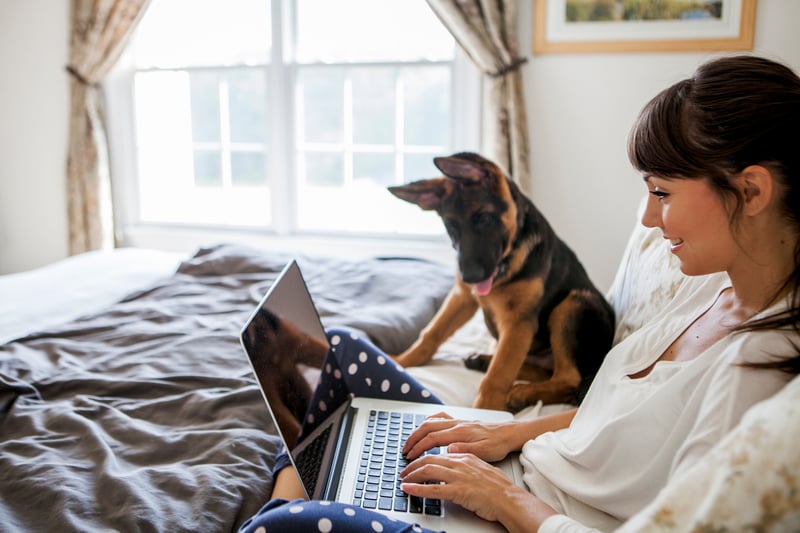
German shepherd dogs are known for their versatility and intelligence. These dogs are one of the most popular breeds of dogs in North America, and people tout these smart, hard-working pets' physical and mental stamina.
While they are great guard dogs when fully grown, these little guys are playful and excited to bond with their humans as puppies and prefer playtime over taking watch! Being prepared is the most important factor for success with German Shepherds.
Tip #1: Support Their Growth
German Shepherds, like many large breeds, can be prone to confirmation-related health issues. That is why it is critical to support their growth carefully, and take a managed approach to their health from the start to help you avoid the pain of joint, bone, and musculoskeletal issues later on.
There are three areas to focus on:
- Diet: Be careful when feeding your German Shepherd puppy because overfeeding can lead to quick growth that leads to improper joint conformation and German Shepherd hip dysplasia. Consult your vet for a feeding schedule, but just because these dogs are bigger doesn’t mean they need exponentially more food.
- Exercise: The same goes with exercise. Intense exercise at a young age can lead to hip dysplasia in your German Shepherd. Walk several shorter walks a day rather than one long one, and avoid "weekend warrior" behavior.
- Supplements: Glucosamine for dogs can help your German Shepherd grow safely, and help their joints develop to be strong. High quality supplements like TRI-ACTA for Pets are perfect for any pup, and offer 100% active ingredients perfect for supporting a growing German Shepherd.
Each component we mentioned above is part of a balanced upbringing for a healthy future!
Tip #2: Train Early
Socialization is key to training any dog, but especially your German Shepherd.
Here are a few new puppy training tips to keep in mind for your German Shepherd:
- Be careful to introduce your German shepherd pup to other dogs gently, but avoid bringing them to a park where there are dozens upon dozens of dogs, some of which may be unleashed or even aggressive.
- Start with a leashed and well-mannered dog, ideally from a distance to let them get to know the dog.
- Build on that experience and introduce friends a few at a time, rather than jumping in with all paws!
Another option is to try an obedience class. Regular puppy classes reduce anxiety, aggression, and stress in dogs. In puppy classes, your German Shepherd can meet other dogs and meet new people in a safe and secure environment. Additionally, these classes can be used to teach your companion basic commands, as well as to prevent (or address) behavior problems like resource guarding.
Final Thoughts
Puppies are wonderful additions to the family, but you should be prepared for some serious work and effort to make their lives better, and by extension, yours too!
Just remember they need the right support on hand to help them grow up strong and healthy.
That includes a joint health supplement designed to support your dog as they grow, with 100% active ingredients that is also a Health Canada approved Veterinary Health Product – TRI-ACTA for pets. This formula is perfect for growing and developing puppies and adults. And when they need a little more from their joint health supplement, try TRI-ACTA H.A. for pets, with the inclusion of hyaluronic acid for greater mobility.
TRI-ACTA for Pets
A proactive approach for developing and younger adult pets to maintain optimal joint health mobility, minimize inflammation and fend off age-related ailments.

Find out where to buy TRI-ACTA or get in contact with us if you have any questions.
Newsletter Signup
Subscribe to our newsletter to receive the latest news and exclusive offers.
.jpg?height=2000&name=Cliick_Integricare-DISPLAY-REVISEDV2%20(1).jpg)
Proactive & Therapeutic Joint Supplements
When given daily, Integricare joint supplements recover bone and joint injuries faster and help prevent mobility injuries from happening in the first place.

